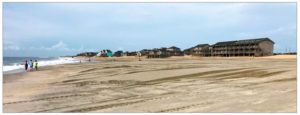The sight of large bulldozers moving sand from the parking lots of the beach front motels on the northern edge of Buxton Village is not unusual. In fact, it can even be encouraging as it indicates that sand is being cleared from NC Highway 12 as well as from the motel parking lots to benefit our residents and visitors. The sand is washed up by heavy storm winds and either hurricanes or northeasters.
well as from the motel parking lots to benefit our residents and visitors. The sand is washed up by heavy storm winds and either hurricanes or northeasters.
So to repair the damage done to our shoreline and the highway, a long planned and hoped for beach nourishment project was begun in early summer of 2017. The project was carefully detailed at a Town Hall meeting with the Dare County Board of Commissioners, and the principal contractors Coastal Science and Engineering and Weeks Marine set the stage for an impressive effort to redress the long-standing problem of severe beach erosion. Cape Hatteras National Seashore Superintendent Dave Hallac was present to describe how the Park Service would coordinate with the contractors to protect both wildlife and beach goers.
The Beach Nourishment Project (capital letters certainly appropriate) is now nearing completion, somewhat beyond the December 2017 estimated project completion date. The delay occurred due to an unusual spate of Atlantic basin storms, including a near-miss by Hurricane Maria 150 miles off shore and some dramatic winter weather that froze the inlets, canals and shorelines along the length of Hatteras Island. These weather anomalies required the temporary withdrawal of the powerful dredges, the C.R. McCaskill and the Magdalen, to safer harbor as they are not able to function in icy conditions and with wave heights above the norm.
The dredges, impressive pieces of nautical equipment, suck sand from a designated barrow pit on the ocean floor approximately 1.7 miles off shore and pipe it to the beach where it is spread by bulldozers. A 2.6 million cubic yards of sand will have been placed on Buxton’s beach for this project. The sand has been applied in small segments, about 250 feet a day, in order to accommodate beach goers, fishermen and surfers. The work areas, about 1,000 feet in total, are identified by flags and will remain off-limits to beach goers for safety until the completion of the project.
Despite nature’s interference, a 2.9 mile portion of shoreline from the Haulover, or Canadian Hole to us long-time folks, to the old site of the Cape Hatteras Lighthouse has been almost completely restored. As of January 9, the Island Free Press reported that 76% of the sand had been placed, and at completion about 140 feet of additional beach would be available for residents and visitors to enjoy.
The Buxton Beach Nourishment Project is exceptional not only for the difficult engineering that it required but also because it demanded a sensitive understanding of the natural environment and its inhabitants ‒ sea turtles, seals, fish and us. The National Park Service was vigilant in protecting fragile and endangered areas and us by flagging sites and removing obstacles. The organizations, agencies and companies involved have made a remarkable effort to use the project as an educational experience ‒ coordinating with the public, state and local agencies, and schools and universities. To learn all we can from the project, we can track the Buxton Beach Nourishment project on the stellar website Morebeachtolove.com. Look it up and revel in the cooperative accomplishment that has brought us our new beach.
